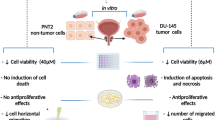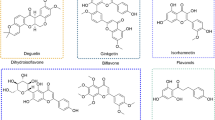Abstract
Purpose
TMFol (3′,4′,5′-trimethoxyflavonol) is a synthetic analogue of the naturally occurring flavonol fisetin and quercetin, which have been considered of potential usefulness in the management of prostate cancer. We investigated whether TMFol may have preclinical features superior to those of its two flavonol congeners.
Methods
The ability of the three flavonols to compromise prostate cancer cell survival was tested in four prostate cancer cell types 22Rv1, TRAMP C2, PC-3 and LNCaP. The effect of TMFol on prostate cancer development in vivo was investigated in nude mice bearing the 22Rv1 or TRAMP C2 tumours.
Results
TMFol inhibited cell growth in vitro in all four prostate cancer cell types more potently than fisetin and quercetin. It also interfered with TRAMP C2 tumour development in vivo, while fisetin and quercetin at equivalent doses were without activity in this model. Likewise, TMFol slowed the growth of the 22Rv1 tumour in vivo. Efficacy in either model was accompanied by induction of apoptosis, although in vitro only TRAMP C2 cells, but not 22Rv1, underwent apoptosis when exposed to TMFol.
Conclusions
The results support the notion that among the three congeneric flavonols, quercetin, fisetin and TMFol, the latter may be the most suitable candidate agent for potential development in prostate cancer management.





Similar content being viewed by others
References
Syed DN, Khan N, Afaq F, Mukhtar H (2007) Chemoprevention of prostate cancer through dietary agents: progress and promise. Cancer Epidemiol Biomark Prev 16:2193–2203
Khan N, Asim M, Afaq F, Abu Zaid M, Mukhtar H (2008) A novel dietary flavonoid fisetin inhibits androgen receptor signaling and tumor growth in athymic nude mice. Cancer Res 68:8555–8563
Haddad AQ, Fleshner N, Nelson C, Saour B, Musquera M, Venkateswaran V, Klotz L (2010) Antiproliferative mechanisms of the flavonoids 2,2′-dihydroxychalcone and fisetin in human prostate cancer cells. Nutr Cancer 62:668–681
Sak K (2014) Site-specific anticancer effects of dietary flavonoid quercetin. Nutr Cancer 66:177–193
Aalinkeel R, Bindukumar B, Reynolds JL, Sykes DE, Mahajan SD, Chadha KC, Schwartz SA (2008) The dietary bioflavonoid, quercetin, selectively induces apoptosis of prostate cancer cells by down-regulating the expression of heat shock protein 90. Prostate 68:1773–1789
Britton RG, Fong I, Saad S, Brown K, Steward WP, Gescher A, Sale S (2009) Synthesis of the flavonoid 3′,4′,5′-trimethoxyflavonol and its determination in plasma and tissues of mice by HPLC with fluorescence detection. J Chromatogr B Analyt Technol Biomed Life Sci 877:939–942
Howells LM, Britton RG, Mazzoletti M, Greaves P, Broggini M, Brown K, Steward WP, Gescher AJ, Sale S (2010) Preclinical colorectal cancer chemopreventive efficacy and p53-modulating activity of 3′,4′,5′-trimethoxyflavonol, a quercetin analogue. Cancer Prev Res (Phila) 3:929–939
Workman P, Aboagye EO, Balkwill F, Balmain A, Bruder G, Chaplin DJ, Double JA, Everitt J, Farningham DA, Glennie MJ, Kelland LR, Robinson V, Stratford IJ, Tozer GM, Watson S, Wedge SR, Eccles SA, Committee of the National Cancer Research I (2010) Guidelines for the welfare and use of animals in cancer research. Br J Cancer 102:1555–1577
Tomayko MM, Reynolds CP (1989) Determination of subcutaneous tumor size in athymic (nude) mice. Cancer Chemother Pharmacol 24:148–154
Britton RG, Horner-Glister E, Pomenya OA, Smith EE, Denton R, Jenkins PR, Steward WP, Brown K, Gescher A, Sale S (2012) Synthesis and biological evaluation of novel flavonols as potential anti-prostate cancer agents. Eur J Med Chem 54:952–958
Halliwell B, Clement MV, Ramalingam J, Long LH (2000) Hydrogen peroxide. Ubiquitous in cell culture and in vivo? IUBMB Life 50:251–257
Saad SE, Jones DJ, Norris LM, Horner-Glister E, Patel KR, Britton RG, Steward WP, Gescher AJ, Brown K, Sale S (2012) Tissue distribution and metabolism of the putative cancer chemopreventive agent 3′,4′,5′-trimethoxyflavonol (TMFol) in mice. Biomed Chromatogr 26:1559–1566
Frost P, Moatamed F, Hoang B, Shi Y, Gera J, Yan H, Frost P, Gibbons J, Lichtenstein A (2004) In vivo antitumor effects of the mTOR inhibitor CCI-779 against human multiple myeloma cells in a xenograft model. Blood 104:4181–4187
Acknowledgments
The study was funded by Grant G2009-25 from Prostate Cancer UK, Cancer Research UK programme Grant C325/A13101 and the Leicester Experimental Cancer Medicines Centre (C325/A15575) and Ph.D. studentship bursaries from the Commonwealth Scholarship Commission in the UK (to CUFKH) and the Libyan Office for Cultural Affairs (to SEAS).
Conflict of interest
None.
Author information
Authors and Affiliations
Corresponding author
Electronic supplementary material
Below is the link to the electronic supplementary material.
Supplemental Fig. 1
Effect of dietary quercetin and fisetin on male nude MF-1 mice bearing the TRAMP C2 prostate cancer. Mice implanted with TRAMP C2 cells received either AIN93G diet (control) or AIN93G diet with quercetin (0.184 % w/w) or fisetin (0.174 % w/w) from seven days prior to cell inoculation until week 7 after cell inoculation. Tumour size was measured by calliper as described under Methods. Values are the mean ± SD of five animals per group. Supplementary material 1 (DOCX 63 kb)
Rights and permissions
About this article
Cite this article
Hill, C.U.F.K., Saad, S.E.A., Britton, R.G. et al. Inhibition of prostate cancer cell growth by 3′,4′,5′-trimethoxyflavonol (TMFol). Cancer Chemother Pharmacol 76, 179–185 (2015). https://doi.org/10.1007/s00280-015-2771-2
Received:
Accepted:
Published:
Issue Date:
DOI: https://doi.org/10.1007/s00280-015-2771-2




